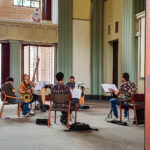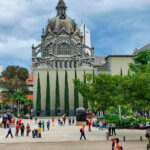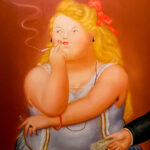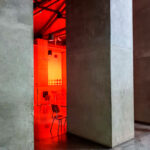Viaje a Medellín, la ciudad de la eterna primavera.
Con 3,9 millones de habitantes, Medellín es la segunda región metropolitana de Colombia. Anteriormente conocida especialmente por los violentos cárteles de la droga en torno a Pablo Escobar, el paisaje de la ciudad ha cambiado por completo desde entonces. En 2012, Medellín fue nombrada una de las ciudades más innovadoras del mundo por el Walls Street Journal, caracterizada por un clima soleado y cálido durante todo el año.
Decidimos tomar el autobús para pasar la noche. Tomamos un taxi hasta la Terminal de Salitre. Al no existir un sistema ferroviario en Colombia, viajar en autobús interurbano es muy popular. Nos sorprendemos mucho cuando entramos en la estación de autobuses. Sólo hay unas pocas personas en la carretera. Al igual que en Alemania, hay muchas medidas de Corona, la gente tiene miedo y sale de su casa sólo para cubrir sus necesidades.
El autobús va poco lleno, así que debería ser un viaje agradable. Llegamos a Medellín a primera hora de la mañana, completamente congelados y sin el mejor de los humores. Al parecer, a los conductores de autobús se les ocurrió combatir un virus con el frío. El aire acondicionado estaba ajustado a lo que parecían 0 grados. Nunca he sentido tanto frío en mi vida.
El clima cálido y agradable y un excelente desayuno en el Cambria Cafe Resto nos hicieron olvidar rápidamente el estresante viaje en autobús. Medellín parece más ordenada y limpia que Bogotá.
No hay grandes baches en las calles y la ciudad tiene un sistema de metro. Lo que inmediatamente llama la atención son los numerosos y coloridos grafitis.
En lo más alto de nuestra lista de cosas por hacer en Medellín está la Comuna13. Este distrito fue considerado durante mucho tiempo una zona prohibida y fue uno de los barrios más peligrosos del mundo, marcado por las guerras de bandas en torno al cartel de Medellín y por los enfrentamientos con la policía.
En la Operación Orión, este barrio se combatió durante 4 días con el uso de militares y helicópteros. Hoy en día, esta parte de la ciudad se considera una atracción turística.
Tomamos un taxi hasta esta parte de la ciudad a primera hora de la mañana. La Comuna 13 se extiende por varias colinas muy empinadas. Las pequeñas casas están construidas muy juntas. Muchos habitantes se ofrecen inmediatamente como guías turísticos. Pero queremos seguir nuestro propio camino.
El arte callejero que vemos es impresionante y conmovedor. Los muros con grafitis cuentan la historia de la Comuna 13, están dedicados a las víctimas y expresan el colorido del mundo colombiano. En cada calle lateral, en cada casa, hay algo que descubrir. El distrito está atravesado por un sistema de escaleras mecánicas que facilita a los residentes el acceso a los barrios superiores. Hay nuevas atracciones en todos los niveles. Caminamos por una calle en la que hay una batalla de DJs: ¿Quién tiene el amplificador más potente? El ruido es ensordecedor.
En muchos lugares vemos actuaciones de hip-hop y break-dance. Aquí se mueven muchos turistas, todo tiene casi un carácter festivo. Aquí casi no hay signos de violencia y delincuencia. Con muchas medidas, también en el sector social, se ha construido aquí algo nuevo. Muchas personas, especialmente los jóvenes, han recibido una nueva perspectiva. Mientras tanto, la Comuna 13 se considera un proyecto modelo en el mundo.
Volvemos a tomar un taxi hacia el centro y visitamos el Museo de Antioqiua. El artista Fernando Botero, originario de Medellín, ha donado una gran colección a este museo, que merece la pena ver. También hay exposiciones de arte contemporáneo y exposiciones permanentes sobre la cultura precolombina del país. El edificio es muy imponente y tiene muchos detalles arquitectónicos que ofrecer. Un hermoso patio interior y la cafetería invitan a quedarse.
Continuamos hacia el Museo de Arte Moderno. Este museo fue reconstruido por muchos millones. Un edificio futurista, pero desgraciadamente las exposiciones no me resultan tan inspiradoras.
Ahora tenemos que organizar las mantas para el viaje de vuelta. No quiero volver a congelarme así.
Travel to Medellín, the city of eternal spring.
With 3.9 million inhabitants, Medellín is the second largest metropolitan region in Colombia. Formerly particularly known for the violent drug cartels around Pablo Escobar, the cityscape has changed completely in the meantime. In 2012, Medellín was named one of the most innovative cities in the world by the Walls Street Journal, characterised by a year-round sunny and warm climate.
We decided to take the bus for the night. We take a taxi to the Terminal de Salitre. As there is no railway system in Colombia, travelling by intercity bus is very popular. We are very surprised when we enter the bus station. There are only a few people on the road. Similar to Germany, there are a lot of Corona measures, people are scared and leave their homes only for the bare necessities.
The bus is only sparsely filled, so it should be a pleasant journey. We arrive in Medellín early in the morning, completely frozen and not in the best of moods. Apparently the bus drivers got the idea to fight a virus with cold. The air conditioning was set to what felt like 0 degrees. I have never felt so cold in my life.
The warm and pleasant climate and an excellent breakfast at Cambria Cafe Resto quickly made us forget the stressful bus ride. Medellín seems tidier and cleaner than Bogota.
There are no big potholes on the streets and the city has a metro system. What immediately catches our eye are the many colourful and expressive graffiti.
At the top of our to-do list for Medellín is Comuna13. This district was long considered a no-go area and it was one of the most dangerous neighbourhoods in the world, marked by gang wars around the Medellín cartel and by clashes with the police.
In Operation Orion, this neighbourhood was fought for 4 days with the use of military and helicopters. Today this part of town is considered a tourist attraction.
We take a taxi to this part of town early in the morning. Comuna 13 stretches over several very steep hills. The small houses are built close together. Many inhabitants immediately offer themselves as tourist guides. But we want to go our own way.
The street art we see is impressive and moving. The graffiti walls tell the story of Comuna 13, are dedicated to victims and express the colourful world of Colombia. In every side street, on every house, there is something to discover. The district is criss-crossed by a system of escalators that makes it easier for residents to get to the upper quarters. There are new attractions on every level. We walk along a street where DJs are having a battle: Who has the strongest amplifier? The noise is deafening.
In many places we see hip-hop and break-dance performances. Many tourists are on the move here, the whole thing almost has a festival character. There is almost no sign of violence and crime here. With many measures, also in the social sector, something new has been built up here. Many people, especially the youth, have been given a new perspective. In the meantime, Comuna 13 is considered a model project in the world.
We take a taxi back to the centre and visit the Museo de Antioqiua. The artist Fernando Botero, who comes from Medellín, has donated a large collection to this museum, which is absolutely worth seeing. There are also exhibitions on contemporary art and permanent exhibitions on the pre-Columbian culture of the country. The building is very imposing and has many architectural details to offer. A beautiful inner courtyard and the café invite you to linger.
We continue to the Museo Arte Moderno. This museum was rebuilt for many millions. A futuristic building but unfortunately the exhibitions are not so inspiring for me.
Now we have to organise blankets for the return journey. I don’t want to freeze like this again.



